Tambor/Gar Class: Difference between revisions
Pbcjohnston (talk | contribs) |
Pbcjohnston (talk | contribs) |
||
| (17 intermediate revisions by the same user not shown) | |||
| Line 2: | Line 2: | ||
=== <big>Design and Construction Notes</big> === | === <big>Design and Construction Notes</big> === | ||
<div style="text-align: justify;"><span style="color:#00008B">The twelve submarines of the Tambor and Gar classes were the high water mark of pre-war submarine construction in the USN. Although authorized in two different fiscal years (FY-39 & 40), the six boats each of the Tambor and Gar classes were actually identical in design with no significant differences between the two groups. They will be treated as one class here on PigBoats. The design of these boats rolled into one all of the lessons that had been learned during the 20 years of peacetime trial and error development, and their origin dates back to the beginning of the V-class in 1921. | <div style="text-align: justify;"><span style="color:#00008B">The twelve submarines of the Tambor and Gar classes were the high water mark of pre-war submarine construction in the USN. Although authorized in two different fiscal years (FY-39 & 40), the six boats each of the Tambor and Gar classes were actually identical in design with no significant differences between the two groups. They will be treated as one class here on PigBoats. The design of these boats rolled into one all of the lessons that had been learned during the 20 years of peacetime trial and error development, and their origin dates back to the beginning of the V-class in 1921. They were well liked and rugged in design and quite advanced for the time. There were however, three criticisms of these boats. Firstly, their design had been optimized for peacetime cruising and thus needed modifications to be optimal to fight the war they faced. Second, they were officially rated with only a 250-foot test depth, an overly conservative value that initially limited underwater evasion tactics. Third, all four engines were contained in one large room, and there were fears of catastrophic flooding should the engine room be breached. In the end these issues were relatively minor in nature, and would be corrected in the follow-on Gato-class. All of these boats turned in superb service during the war. | ||
Maintaining the construction trend that had started with the Porpoise class, the Tambor/Gars were divided up for construction between the Portsmouth Navy Yard (four boats), Electric Boat (six boats), and the Mare Island Navy Yard (two boats). Based on repeated calls by the Submarine Officers Conference for a heavier armament, these boats were equipped with six bow and four stern 21" torpedo tubes, carrying a total of 24 torpedoes. For gun armament, they were built with a 3"/50 caliber Mk 17 gun and one or two Browning M2 .50 caliber water-cooled machine guns. Starting in the summer of 1942, six of these boats (Tambor, Thresher, Tuna, Gar, Grayback, and Grayling) were refitted to carry a much larger and more powerful 5"/51 caliber Mk 9 gun, located on an expanded sponson on the aft deck. Three of the guns had been originally installed on the earlier Barracuda-class fleet boats, the other three were production spares. Gun armament varied considerably during the war, with the boats that did not get the big gun getting a 4"/50 caliber Mk 9 gun, taken mostly from older S-boats. | |||
These boats were in the thick of the fight against the Japanese from the first day of the war. Seven of them (marked by a *) and their brave crews were lost in action and are considered to be "on eternal patrol". | |||
As with all of the pre-war built fleet submarines, once the war started their external appearance was heavily modified as experience was gained. These changes came fast and often, and it is easy to be confused by it all. The authors highly recommend that you read the Visual Guide article posted [https://pigboats.com/images/3/3b/A_VISUAL_GUIDE_TO_THE_FLEET_SUBMARINES_PART_4_GATO_CLASS_2024.pdf '''at this link''']. | |||
</span></div> | |||
[[File:Red bar sub new 2.jpg]] | [[File:Red bar sub new 2.jpg]] | ||
=== <big>Tambor (SS-198)</big> === | === <big>Tambor (SS-198)</big> === | ||
[[File:198-1.jpg|left| | [[File:198-1.jpg|left|500px|National Archives photo.]] | ||
<div style="text-align: justify;"><span style="color:#00008B">Tambor underway on builder's trials off Provincetown, MA., April 8, 1940. This is a very typical appearance for the pre-war boats. The Tambor/Gar class boats, along with a few of the early Gatos, were the last boats built with a periscope station in the control room. This is indicated by the stepped appearance of the periscope shears. Both of the periscopes are 40-foot long models, but the eyepiece of #1 scope is in the control room giving it the external appearance of being shorter.</span> | <div style="text-align: justify;"><span style="color:#00008B">Tambor underway on builder's trials off Provincetown, MA., April 8, 1940. This is a very typical appearance for the pre-war boats. The Tambor/Gar class boats, along with a few of the early Gatos, were the last boats built with a periscope station in the control room. This is indicated by the stepped appearance of the periscope shears. Both of the periscopes are 40-foot long models, but the eyepiece of #1 scope is in the control room giving it the external appearance of being shorter. The Electric Boat built versions of this class had a unique modification. The towing fairlead (bullnose) was faired into the tip of the bow. The boats built at Navy yards had the older style above deck bullnose (see Triton and Tuna photo below.)</span> | ||
[[198|See more Tambor photos]] | [[198|See more Tambor photos]] | ||
| Line 18: | Line 22: | ||
=== <big>Tautog (SS-199)</big> === | === <big>Tautog (SS-199)</big> === | ||
[[File]] | |||
<div style="text-align: justify;"><span style="color:#00008B"> | [[File:Tautog stbd quarter 1940.jpg|left|500px|U.S. Navy photo.]] | ||
<div style="text-align: justify;"><span style="color:#00008B">Tautog underway in Cape Cod Bay after running the measured mile off Provincetown, MA., July 1940. This photo highlights one of the prime differences between the Tambor/Gar-class boats and earlier classes. The superstructure now ends short of the stern. On the aft deck is the 3"/50 caliber Mk 17 gun. The mount is quite tall and is visually distinctive. The intention here was to provide the ability to greatly elevate the gun for use with fused anti-aircraft rounds. In practice the boats were rarely supplied with such rounds, as it was felt that taking on aircraft was far too dangerous.</span> | |||
[[199|See more Tautog photos]] | [[199|See more Tautog photos]] | ||
| Line 26: | Line 31: | ||
=== <big>Thresher (SS-200)</big> === | === <big>Thresher (SS-200)</big> === | ||
[[File]] | |||
<div style="text-align: justify;"><span style="color:#00008B"> | [[File:Thresher near bridge.jpg|left|500px|U.S. Navy photo. An original print in the private collection of Ric Hedman.]] | ||
<div style="text-align: justify;"><span style="color:#00008B">Thresher passing under the U.S. Route 1 Bridge spanning the Thames River between New London and Groton, CT. The date is 1940. Judging by the wake she is running at approximately six knots, but unusually she is running on the battery. No diesel exhaust or overboards are seen. It looks like she is headed upriver towards Submarine Base New London. This would explain the large number of men topside. They are anticipating their return home.</span> | |||
[[200|See more Thresher photos]] | [[200|See more Thresher photos]] | ||
| Line 34: | Line 40: | ||
=== <big>Triton (SS-201)*</big> === | === <big>Triton (SS-201)*</big> === | ||
[[File]] | |||
<div style="text-align: justify;"><span style="color:#00008B"> | [[File:Triton classic photo.jpg|left|500px|Photo NH 99279 courtesy of NHHC.]] | ||
<div style="text-align: justify;"><span style="color:#00008B">An often seen but classic photo of the Triton on maneuvers in the Caribbean in early 1941. One of her sister boats is in the background, likely Trout. The Tambor/Gar-class submarines were the epitome of everything that had been learned about submarine technology and tactics over the previous 20 years of trial and error, and this picture amply illustrates the level to which this development reached in the final months of peace. These were handsome boats and they cut a fine figure at sea. Note the above deck towing fairlead (aka bullnose) at the tip of the bow. The EB version was faired into the deck tip.</span> | |||
[[201|See more Triton photos]] | [[201|See more Triton photos]] | ||
| Line 42: | Line 49: | ||
=== <big>Trout (SS-202)*</big> === | === <big>Trout (SS-202)*</big> === | ||
[[File]] | |||
<div style="text-align: justify;"><span style="color:#00008B"> | [[File:Trout like new.jpg|left|500px|Photo in the private collection of Ric Hedman.]] | ||
<div style="text-align: justify;"><span style="color:#00008B">USS Trout underway in the Atlantic shortly after her commissioning, early 1941. </span> | |||
[[202|See more Trout photos]] | [[202|See more Trout photos]] | ||
| Line 50: | Line 58: | ||
=== <big>Tuna (SS-203)</big> === | === <big>Tuna (SS-203)</big> === | ||
[[File]] | |||
<div style="text-align: justify;"><span style="color:#00008B"> | [[File:Tuna with damage.jpg|left|500px|Photo 19-N-24094 courtesy of NARA.]] | ||
<div style="text-align: justify;"><span style="color:#00008B">Two months after her commissioning, Tuna was caught by a photographer in San Francisco Bay. Tuna was one of two boats of this class built at the Mare Island Navy Yard. Unusually, Tuna is showing some minor damage to the bottom edge of her superstructure, between the folded bow planes and the conning tower fairwater. A small portion of the bottom edge has been pushed in, and two wedges are keeping it from bending further in a sea state. The damage may have been caused by a tug impacting the superstructure. It is possible Tuna is headed back to the yard for a fix. One other interesting feature is the hook shaped mount for a water-cooled Browning M2 .50 caliber machine gun atop the covered pilothouse on the front of the conning tower fairwater. On some other boats this mount was on the forward deck. Placing the mount here allowed the gunner a very wide arc of fire. There was another mount on the "cigarette deck" aft of the bridge. That mount is not seen here because of the bulwark surrounding it. The .50 caliber gun was small enough that it was dismounted and taken below before diving.</span> | |||
[[203|See more Tuna photos]] | [[203|See more Tuna photos]] | ||
| Line 58: | Line 67: | ||
=== <big>Gar (SS-206)</big> === | === <big>Gar (SS-206)</big> === | ||
[[File]] | |||
<div style="text-align: justify;"><span style="color:#00008B"> | [[File:Gar at EB.jpg|left|500px|Photo courtesy of the Submarine Force Library & Museum.]] | ||
<div style="text-align: justify;"><span style="color:#00008B">A brand new but not yet commissioned Gar alongside the fitting out pier at the Electric Boat Company, Groton, CT., April 1941. She is essentially complete at this point, and is just awaiting some finishing touches before the Navy accepts her into service. This photo gives a very good view of the faired in bullnose of the EB design. Grampus (SS-207) sits at the next pier over.</span> | |||
[[206|See more Gar photos]] | [[206|See more Gar photos]] | ||
| Line 66: | Line 76: | ||
=== <big>Grampus (SS-207)*</big> === | === <big>Grampus (SS-207)*</big> === | ||
[[File]] | |||
<div style="text-align: justify;"><span style="color:#00008B"> | [[File:Grampus on trials.jpg|left|500px|Photo 19-N-23818 courtesy of NHHC.]] | ||
<div style="text-align: justify;"><span style="color:#00008B">Grampus patiently waiting to get her picture taken, March 26, 1941. The location is probably the waters off Provincetown, MA. in Cape Cod Bay. She has been running her builder's trials, a series of tests run by Electric Boat personnel designed to wring out all systems. Discrepancies found will be corrected once they return to the yard. At this point the boat is still under the ownership of EB. Elements of her Navy crew would be aboard to observe and train, but she is under the full control of EB. An accommodation ladder has been rigged up on the port side, undoubtedly to pick up the photographer from the trailing small boat. </span> | |||
[[207|See more Grampus photos]] | [[207|See more Grampus photos]] | ||
| Line 74: | Line 85: | ||
=== <big>Grayback (SS-208)*</big> === | === <big>Grayback (SS-208)*</big> === | ||
[[File]] | |||
<div style="text-align: justify;"><span style="color:#00008B"> | [[File:Grayback 1943.jpg|left|500px|USN photo 6139-43, courtesy of Darryl L. Baker via Navsource.org]] | ||
<div style="text-align: justify;"><span style="color:#00008B">Grayback viewed here broad on the starboard side in San Francisco Bay after her last wartime overhaul, August 26, 1943. Her conning tower fairwater sports a Mod 3 Long Bridge configuration, with the forward and aft portions cut away with 20mm guns added on those gun decks, SJ radar added to the front of the periscope shears and SD added aft of the shears. Grayback is one of the six Tambor/Gar-class boats that received the large and powerful 5"/51 caliber Mk 9 gun. The gun was large enough that an expanded sponson had to be built around the aft gun mount to give the gun crew enough deck space to train the gun.</span> | |||
[[208|See more Grayback photos]] | [[208|See more Grayback photos]] | ||
| Line 82: | Line 94: | ||
=== <big>Grayling (SS-209)*</big> === | === <big>Grayling (SS-209)*</big> === | ||
[[File]] | |||
<div style="text-align: justify;"><span style="color:#00008B"> | [[File:Grayling at speed.jpg|left|500px|Photo 19-N-25898 courtesy of NHHC.]] | ||
<div style="text-align: justify;"><span style="color:#00008B">USS Grayling making a speed run off Portsmouth, NH., November 12, 1941 in those last days before the war. She is making nearly her full speed, 18.2 knots and is throwing up quite a bow wave. Grayling had been in commission 8½ months at this point, and shortly after this photo was taken she would head to the Pacific to join the fleet. She was in San Diego when the war started.</span> | |||
[[209|See more Grayling photos]] | [[209|See more Grayling photos]] | ||
| Line 90: | Line 103: | ||
=== <big>Grenadier (SS-210)*</big> === | === <big>Grenadier (SS-210)*</big> === | ||
[[File]] | |||
<div style="text-align: justify;"><span style="color:#00008B"> | [[File:Grenadier launch.jpg|left|500px|Photo 08 06 023289 courtesy of the Boston Public Library, Leslie Jones Collection]] | ||
<div style="text-align: justify;"><span style="color:#00008B">Grenadier shortly after launch from the Portsmouth Navy Yard, Kittery, ME. on a cold but calm November 29, 1940. Much work remains to be done, including the installation of her periscope shears and masts. This photo gives a good view of the Government design for the towing fairlead bullnose, which is the old style above deck steel ring.</span> | |||
[[210|See more Grenadier photos]] | [[210|See more Grenadier photos]] | ||
| Line 98: | Line 112: | ||
=== <big>Gudgeon (SS-211)*</big> === | === <big>Gudgeon (SS-211)*</big> === | ||
[[File]] | |||
<div style="text-align: justify;"><span style="color:#00008B"> | [[File:Gudgeon 1943.jpg|left|500px|Photo 5767-43 from NARA San Francisco via Tracy White and Navsource.org]] | ||
<div style="text-align: justify;"><span style="color:#00008B">An excellent starboard side view of Gudgeon, August 7, 1943 after an overhaul and modernization at Mare Island. She is very similar to Grayback at this time, with a Mod 3 Long Bridge conning tower fairwater variation. The SJ radar mast is prominent above the bridge. Both periscopes are lowered but the SD radar mast is fully raised. The circular loop aft of the SD mast is a radio direction finder (RDF) loop which could be used in an intelligence role or as a navigation aid. The expanded sponson for the big 5"/51 caliber deck gun is quite apparent. </span> | |||
[[211|See more Gudgeon photos]] | [[211|See more Gudgeon photos]] | ||
[[File:Red bar sub new | [[File:Red bar sub new.jpg]] | ||
<center>[[Submarine Classes|Return to the Submarine Classes page]]</center> | |||
[[File:Red bar sub new.jpg]] | |||
<center> | <center> | ||
<span style="color:#00008B"> | <span style="color:#00008B"> | ||
Latest revision as of 12:15, 16 October 2024
Design and Construction Notes
Maintaining the construction trend that had started with the Porpoise class, the Tambor/Gars were divided up for construction between the Portsmouth Navy Yard (four boats), Electric Boat (six boats), and the Mare Island Navy Yard (two boats). Based on repeated calls by the Submarine Officers Conference for a heavier armament, these boats were equipped with six bow and four stern 21" torpedo tubes, carrying a total of 24 torpedoes. For gun armament, they were built with a 3"/50 caliber Mk 17 gun and one or two Browning M2 .50 caliber water-cooled machine guns. Starting in the summer of 1942, six of these boats (Tambor, Thresher, Tuna, Gar, Grayback, and Grayling) were refitted to carry a much larger and more powerful 5"/51 caliber Mk 9 gun, located on an expanded sponson on the aft deck. Three of the guns had been originally installed on the earlier Barracuda-class fleet boats, the other three were production spares. Gun armament varied considerably during the war, with the boats that did not get the big gun getting a 4"/50 caliber Mk 9 gun, taken mostly from older S-boats.
These boats were in the thick of the fight against the Japanese from the first day of the war. Seven of them (marked by a *) and their brave crews were lost in action and are considered to be "on eternal patrol".
As with all of the pre-war built fleet submarines, once the war started their external appearance was heavily modified as experience was gained. These changes came fast and often, and it is easy to be confused by it all. The authors highly recommend that you read the Visual Guide article posted at this link.
Tambor (SS-198)

Tautog (SS-199)
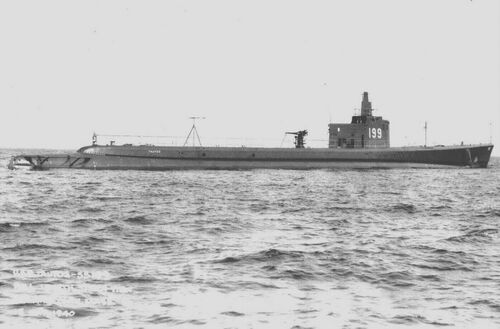
Thresher (SS-200)
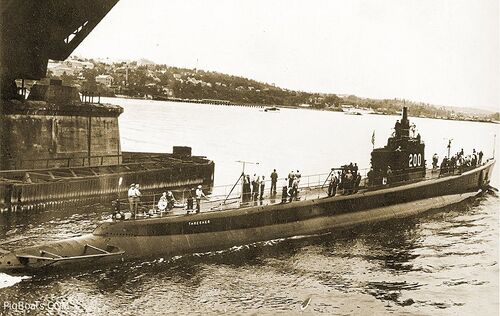
Triton (SS-201)*
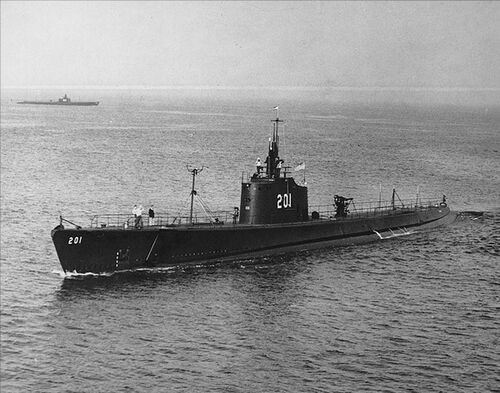
Trout (SS-202)*
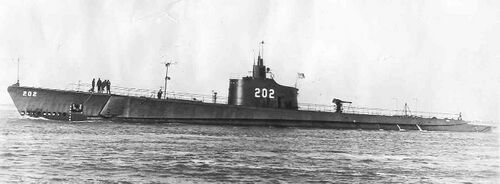
Tuna (SS-203)

Gar (SS-206)
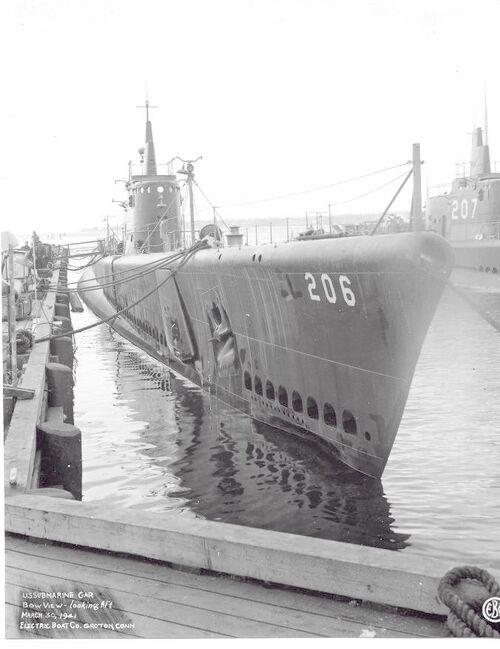
Grampus (SS-207)*

Grayback (SS-208)*
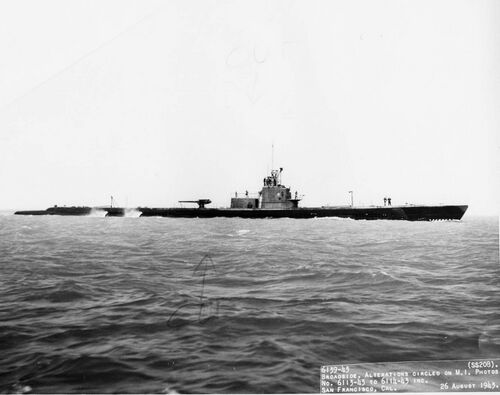
Grayling (SS-209)*
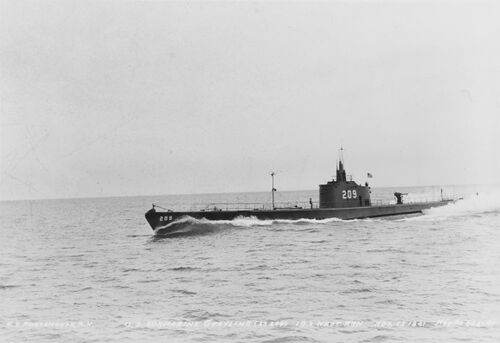
Grenadier (SS-210)*
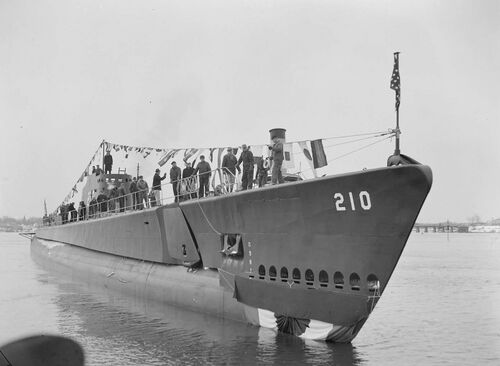
Gudgeon (SS-211)*

Page created by:
Ric Hedman & David Johnston
1999 - 2023 - PigBoats.COM©
Mountlake Terrace, WA, Norfolk, VA
webmaster at pigboats dot com
